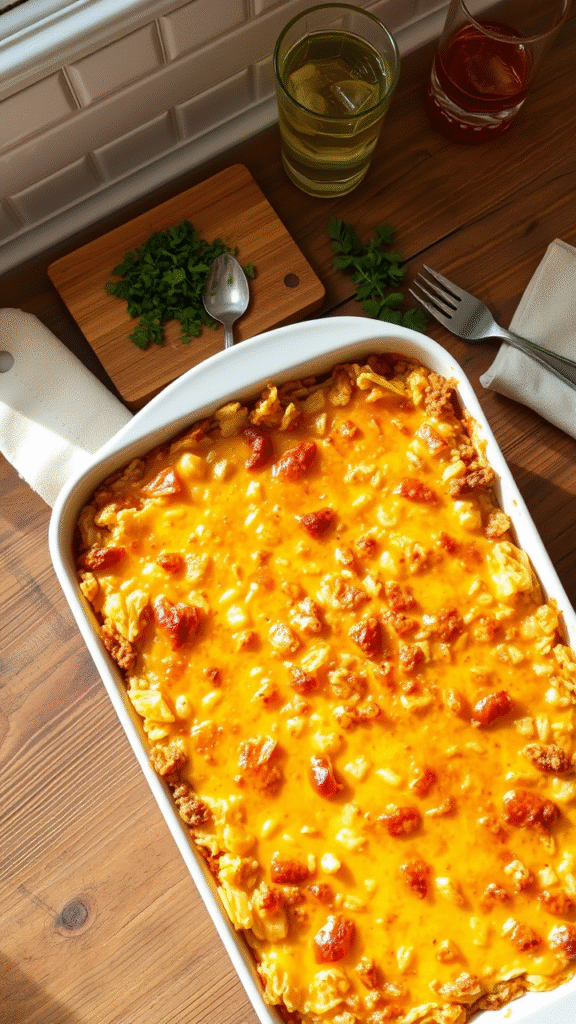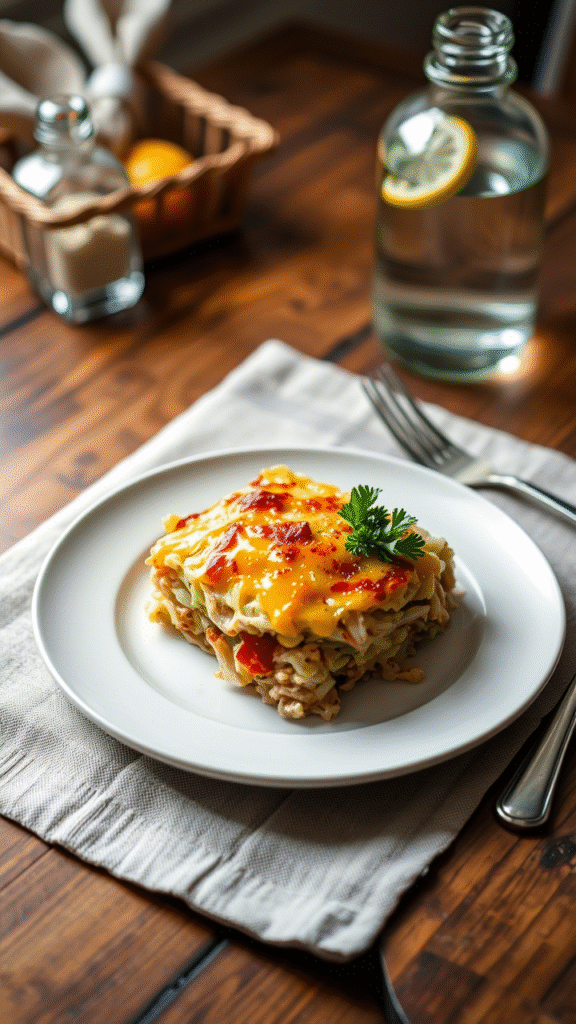There’s something about a casserole that just hits the spot. It’s that all-in-one, hearty meal that fills you up without too much fuss. Cabbage casserole, though, might not always get the love it deserves. But trust me, it deserves more attention. When done right, cabbage casserole is a beautifully balanced dish, combining tender cabbage, rich flavors, and a comforting, cheesy finish. It’s the kind of dish that keeps you coming back for more, even though you might not have thought you’d love it so much.
Why cabbage? Well, cabbage is a humble, nutrient-packed vegetable that often gets overlooked. It’s affordable, versatile, and can take on so many forms—from slaws to stir-fries. But baked into a casserole with the right ingredients, cabbage transforms into something warm, filling, and absolutely crave-worthy.
In this article, we’ll dive deep into how to make cabbage casserole that doesn’t just satisfy your hunger but delights your taste buds. Plus, I’ll share tips and tricks along the way to make sure you nail the recipe every single time.
Ingredients & Substitutions

Here’s what you’ll need for a classic cabbage casserole:
- Cabbage (1 medium head) – This is the star of the show, so pick a firm, fresh head. Look for tightly packed leaves with no yellowing. Fresh cabbage makes all the difference, trust me.
- Ground meat (1 lb) – You can go with beef, pork, turkey, or even a plant-based option like lentils or mushrooms if you prefer a vegetarian version. Ground beef works best, but leaner meats may make the casserole feel a bit too dry if you’re not careful.
- Onion (1 medium) – You’ll sauté this at the beginning to bring out sweetness. It’s one of those ingredients you can’t skip.
- Garlic (3 cloves) – Minced garlic provides that deep, aromatic flavor that really enhances the whole dish. Fresh is always best, but in a pinch, garlic powder works, though it won’t have the same intensity.
- Tomato paste (2 tbsp) – Adds a touch of umami and acidity, balancing out the richness of the casserole.
- Rice (1 cup, uncooked) – You’ll want to use white rice, though brown rice could be used if you prefer the extra fiber. If you’re gluten-free, you can swap rice for quinoa or gluten-free pasta.
- Cheese (2 cups, shredded) – A mix of mozzarella and cheddar is ideal. The mozzarella adds that gooey, melt-in-your-mouth texture, while the cheddar brings a sharp, tangy kick.
- Eggs (2 large) – These are the binding agents. They help hold everything together and give the casserole its signature consistency.
- Cream (½ cup) – Heavy cream, for that richness. If you’re looking for a lighter version, you can swap this for sour cream or even Greek yogurt.
- Seasonings – Salt, pepper, paprika, and dried thyme. These simple seasonings elevate the dish without overwhelming it.
Substitutions for Special Diets

Now, if you’re catering to specific dietary needs or preferences, here are a few easy substitutions:
- Vegetarian version: Swap the meat for lentils, mushrooms, or plant-based ground meat. Mushrooms bring a meaty texture that mimics ground beef, and lentils are hearty and filling.
- Dairy-free: Use a dairy-free cheese blend and substitute the cream with coconut cream or a non-dairy milk (like almond or oat milk). Nutritional yeast can add that cheesy flavor too.
- Low-carb: Instead of rice, you could use cauliflower rice or just skip it entirely for a low-carb version. Adding a few more veggies like bell peppers or zucchini will keep the dish satisfying.
- Gluten-free: Ensure your rice is gluten-free and skip any breadcrumbs if you decide to top your casserole with a crispy finish.
Step-by-Step Instructions
Let’s walk through the process of making this cabbage casserole. It’s easy enough for a weeknight dinner but impressive enough to serve at a gathering.
1. Preheat and Prepare
Start by preheating your oven to 375°F (190°C). Grease a 9×13-inch casserole dish. It’s a good idea to oil it lightly so the casserole doesn’t stick, but don’t overdo it; we want the dish to crisp up on the edges, not be too greasy.
2. Cook the Meat
In a large skillet, heat some olive oil over medium heat. Add the ground meat and cook it until browned. You want it to get a nice caramelization, so don’t rush this part. The color and texture you get here will add depth to the flavor.
Once the meat is cooked, toss in your chopped onions and garlic. Stir them in and cook until the onions are soft and translucent. This usually takes about 3-4 minutes. You’ll start to smell that sweet, savory aroma—this is the base of your casserole flavor.
3. Add Tomato Paste & Seasonings
Next, add the tomato paste, and stir it into the meat mixture. This is where things get interesting. The paste will caramelize slightly in the hot pan, giving off a rich, almost sweet flavor. Now, sprinkle in your seasonings—salt, pepper, paprika, and thyme. Mix everything together, and let it cook for another minute or two to meld the flavors.
4. Prepare the Cabbage
While the meat and onions are cooking, chop up the cabbage. You don’t want it too finely shredded—go for medium-sized pieces. If you’re really pressed for time, you can buy pre-shredded cabbage. But there’s something about chopping it fresh that adds a special touch.
You don’t need to pre-cook the cabbage, just toss it raw into the casserole dish. The cabbage will soften and cook down in the oven, blending beautifully with the other ingredients.
5. Assemble the Casserole
Now comes the fun part: assembly. Layer the cabbage at the bottom of your casserole dish, then pour the meat mixture over the top. Add your rice and eggs (whisked with the cream), and spread it evenly over the casserole. Finally, sprinkle the shredded cheese on top, making sure it covers the whole surface.
6. Bake
Cover the dish with foil and bake for 30 minutes. After that, remove the foil and bake for an additional 15-20 minutes, or until the cheese is golden and bubbly. The edges of the cabbage should be crispy and slightly caramelized—this is where the magic happens.
7. Let it Set and Serve
Once you’ve pulled it from the oven, let it sit for about 10 minutes. This helps it set and makes it easier to serve. Slice it up like a lasagna, and enjoy!
Cooking Techniques & Science

So, why do we sauté the meat and onions first? Simple. Browning the meat adds flavor through the Maillard reaction. This is a chemical process where the proteins and sugars in the meat react to form new, flavorful compounds. The onions caramelize as they cook, developing natural sweetness that balances the savory meat.
Baking the cabbage uncooked allows it to maintain some texture, but it also releases its moisture during cooking. This moisture helps soften the casserole without turning it soggy, creating that perfect balance between tender and crunchy.
The eggs, when mixed with cream and rice, act as a binder. They hold the casserole together, giving it that satisfying, firm yet creamy texture.
Serving & Pairing Suggestions
Cabbage casserole is hearty enough to stand alone, but here are a few ideas for sides:
- Side Salad: A fresh green salad with a light vinaigrette will cut through the richness of the casserole.
- Bread: Serve it with crusty bread or garlic bread to scoop up the cheesy goodness. It’s a great way to soak up any sauce that might be left on your plate.
- Drink Pairing: A light, crisp white wine, like a Sauvignon Blanc, pairs beautifully with the richness of this dish. Alternatively, a cold, refreshing beer (think pilsner or lager) works well too.
Conclusion
Cabbage casserole might not be the first dish that comes to mind when you think of comfort food, but once you try this recipe, you’ll understand why it should be. It’s simple, affordable, and packs so much flavor in each bite. Whether you’re cooking for your family, a special occasion, or just because, this dish won’t disappoint.
One last tip—don’t rush the browning of the meat and onions. It’s those extra few minutes that make a world of difference. Enjoy!
Frequently Asked Questions
Can I make this casserole ahead of time?
Yes, you can! Assemble it the night before, cover it tightly with plastic wrap or foil, and store it in the fridge. Just pop it in the oven the next day for a quick reheat.
Can I freeze cabbage casserole?
Absolutely! Once the casserole is baked and cooled, wrap it tightly in plastic wrap and foil. Freeze for up to 3 months. When you’re ready to eat it, thaw overnight in the fridge and bake as usual.
How can I make this dish spicier?
If you like some heat, try adding a chopped jalapeño to the meat mixture or a teaspoon of red pepper flakes. You can also top the casserole with a spicy salsa before serving.
What if I don’t have tomato paste?
You can substitute with a bit of tomato sauce, but use less, as it’s thinner. You could also add a little sugar to mimic the sweetness of the paste.
How can I avoid the cabbage being too soggy?
Make sure not to overcook the cabbage before baking. The cabbage should go into the casserole raw, and it will soften and release moisture in the oven. If it’s overcooked beforehand, it could turn too mushy.

Food lover, recipe creator & the heart behind NoshCrafters.com. Olivia shares mouthwatering, easy-to-make dishes that turn everyday meals into unforgettable bites. When she’s not experimenting in the kitchen, she’s busy plating up inspiration for home cooks everywhere.